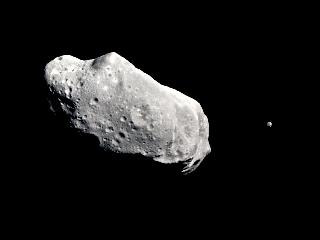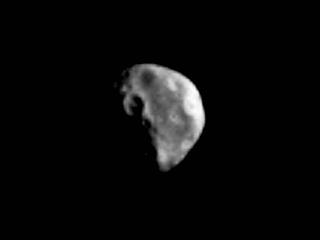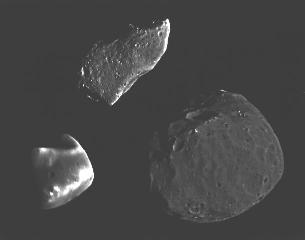Satellites of Minor Planets
Tom Van Flandern, Meta Research
This article presents one view on the origin of asteroids. It is extracted from the Meta Research Bulletin for March, 1994, published by Meta Research, Inc., P.O. Box 15186, Chevy Chase, Md. The pictures and information on the Galileo mission imaging at the end of the article were downloaded from the NASA Jet Propulsion Laboratory web site at http://www.jpl.nasa.gov/
One of the key predictions of the exploded planet hypothesis is that most minor planets will be accompanied by debris clouds, the larger fragments of which would be classified as "minor satellites". If the thousands of objects orbiting between Mars and Jupiter did indeed originate in a planetary explosion, then satellites of minor planets must be both numerous and commonplace. Evidence of just that has accumulated over the years, but has been hotly disputed by mainstream asteroid experts ("asteroid" and "minor planet" are synonymous). This is because satellites cannot get into stable orbits under normal circumstances if the standard paradigm is correct -- that minor planets or their parent bodies condensed from the primeval solar nebula. So the prediction that such satellites are abundant is indeed a decisive one for choosing between the two competing theories. Most existing prior evidence for asteroid moons was collected through the International Occultation Timing Association (IOTA)'s efforts at the initiative of astronomer David Dunham. Dunham also reported the first asteroid moon recognized for what it was to the American Astronomical Society following a discovery observation by observer Paul Maley in 1977.
The following press bulletin was released by NASA's Jet Propulsion Laboratory in Pasadena, California:
NASA's Galileo spacecraft observed what is probably a natural satellite of the asteroid Ida -- which would be the first moon of an asteroid ever sighted -- during its flyby, scientists have reported. The object is revealed in data transmitted by the spacecraft. Sampled data from both Galileo's solid-state imaging system and its near-infrared mapping spectrometer give indications of the object.
InMetaRes.Bull. 1, 4-6 (1992), we published "First asteroid images: satellite analysis", reporting on the same spacecraft's first asteroid encounter with Gaspra in October, 1991. An earlier article predicting that the spacecraft would find satellites appeared in "Minor satellites and the Gaspra encounter", in Asteroids, Comets, Meteors 1991, A.W. Harris and E. Bowell, eds., Lunar & Planetary Institute, Houston, TX, 609-612 (1992). No orbiting satellites turned up in the Gaspra encounter. However, I quote here one paragraph from the preliminary analysis results of that earlier event from the Meta Research Bulletin (MRB) article. This same quote also appears on p. 178 of the author's book Dark Matter, Missing Planets and New Comets, in which chapter 8 is devoted to the history of earlier minor satellite observations.
"... Gaspra might have no moons only because of a collision event. I had said [before the spacecraft encounter], 'Even so, tidal forces prior to the collision would have operated to bring down minor satellites orbiting inside the synchronous orbit, which for Gaspra is about two mean diameters out. They should end up lying on the surface of the nucleus.' Near one edge of the image sent by the spacecraft, there is a large object about 5 km long which appears to be a physically distinct piece lying on the surface of an otherwise contiguous body. This is just the sort of object I anticipated with my remark. The proof of its origin as a moon of Gaspra could come in later photos if tracks caused by the object rolling after decaying from orbit can still be seen."
Additional photographs of Gaspra became available when the Galileo spacecraft returned to the vicinity of the Earth on its complex journey. These photos did indeed confirm this last prediction very well. Three parallel grooves lead up to the snout-shaped object. Although the origin of these peculiar surface markings is still debated, roll-marks made by the 5-km body appear to be an excellent explanation consistent with all known facts. So Gaspra might be considered as in accord with the pre-encounter prediction of minor satellites, but in a somewhat ambiguous way. It was clear that most astronomers would remain unconvinced until a spacecraft returned pictures of a satellite in the act of orbiting a minor planet right now.
 The August, 1993, flyby of minor planet Ida by the Galileo spacecraft appears to have provided that confirmation. Ida is essentially a randomly selected asteroid for this purpose, since it simply happened to lie near the spacecraft's flight path to Jupiter through the main asteroid belt. It is only the second asteroid ever examined close-up by a spacecraft. The new pictures indicate it has at least one currently orbiting satellite. So little of the space around Ida has yet been examined that it may perhaps have many more. [Problems with the spacecraft antenna have prevented downloading the background on the pictures taken by the spacecraft, in order to save spacecraft and telescope time. A few single lines were downloaded from each picture to locate the asteroid image, and only that image was to be downloaded to Earth at the slow data rate of the antenna. But even in the small area of space around the asteroid sampled by these test lines, one satellite has turned up. We may expect that many additional satellites (probably dozens, possibly hundreds, many of them in orbits having the same period as the asteroid's rotation) of various sizes down to the limit of camera resolution would be seen if the full pictures could be downloaded. But that is not presently part of the operating plan for recovering the data from the spacecraft's tape recorder. So we must depend on chance to show additional moons that may be there.]
The August, 1993, flyby of minor planet Ida by the Galileo spacecraft appears to have provided that confirmation. Ida is essentially a randomly selected asteroid for this purpose, since it simply happened to lie near the spacecraft's flight path to Jupiter through the main asteroid belt. It is only the second asteroid ever examined close-up by a spacecraft. The new pictures indicate it has at least one currently orbiting satellite. So little of the space around Ida has yet been examined that it may perhaps have many more. [Problems with the spacecraft antenna have prevented downloading the background on the pictures taken by the spacecraft, in order to save spacecraft and telescope time. A few single lines were downloaded from each picture to locate the asteroid image, and only that image was to be downloaded to Earth at the slow data rate of the antenna. But even in the small area of space around the asteroid sampled by these test lines, one satellite has turned up. We may expect that many additional satellites (probably dozens, possibly hundreds, many of them in orbits having the same period as the asteroid's rotation) of various sizes down to the limit of camera resolution would be seen if the full pictures could be downloaded. But that is not presently part of the operating plan for recovering the data from the spacecraft's tape recorder. So we must depend on chance to show additional moons that may be there.]
 Conservative scientists are quick to point out that one satellite of one minor planet does not prove that minor satellites are "numerous and commonplace", as the exploded planet hypothesis predicts. Indeed, imaging team leader Michael Belton is quoted by Sky & Telescope magazine as cautioning that there's a remote chance that a small, previously undetected asteroid just happened to be whizzing past Ida at just that moment. But the probability of this may be compared with the probability that, during your one-hour visit to New York or Los Angeles, the city is completely destroyed by the impact of an asteroid from space.
Conservative scientists are quick to point out that one satellite of one minor planet does not prove that minor satellites are "numerous and commonplace", as the exploded planet hypothesis predicts. Indeed, imaging team leader Michael Belton is quoted by Sky & Telescope magazine as cautioning that there's a remote chance that a small, previously undetected asteroid just happened to be whizzing past Ida at just that moment. But the probability of this may be compared with the probability that, during your one-hour visit to New York or Los Angeles, the city is completely destroyed by the impact of an asteroid from space.
Therefore, I suspect that those with a good sense of the laws of probability must realize that finding a moon of an asteroid during only the second spacecraft encounter with one implies that minor satellites are at least not rare. When this discovery is combined with earlier occultation and radar data suggesting that the majority of asteroids examined have companions (at least coalesced ones), it is perhaps not too soon to anticipate that this critical test is turning out in favor of the exploded planet hypothesis, and against the hypothesis of origin of minor planets by condensation from the solar nebula. [The latest radar results showing the contact-binary nature of asteroid Castilia (1989 PB) are reported by R. Hudson and S. Ostro, Science 263, 940-943 (1994).]
It might be added that, in addition to all the other evidence for the exploded planet hypothesis (see chapter 11 of Dark Matter, ...), the Galileo spacecraft also detected evidence of a magnetic field during its flyby of Ida. According to JPL's press release about that finding, "Before Galileo's Gaspra encounter in October 1991, small asteroids generally were not expected to possess their own magnetic fields, though some meteorites - believed to be fragments of asteroids - have measurable fields." This is because small bodies such as asteroids, even up to the size of Earth's Moon, are unlikely to have the high temperatures and pressures in their interiors generally associated with planetary magnetic fields.
Moreover, both Gaspra and Ida were believed to be mainly stony, rather than iron as in the magnetic meteorites. So finding magnetic fields there came as quite a surprise. Yet, if the asteroids are fragments of a major planet, it would be no surprise that each fragment preserved a fossilized magnetic field from its parent planet, frozen in place during the billions of years it spent inside that planet.
Implications: Why can't abundant satellites exist in the standard model? Suppose the satellites come from outside the sphere of influence of the parent asteroid. Then gravitational capture is impossible for several reasons. In the two-body problem, gravitational capture is impossible under any circumstances, as long as gravity is the only force acting. If a third body intervenes, then temporary captures are possible, but escape back to a solar orbit is inevitable, usually after only one or a few revolutions as a satellite. In both cases of external origin, a stable capture might occur if a non-gravitational force acts too. But all known non-gravitational forces acting on asteroids except collisions are negligible in strength compared to gravitation, and have apparently always been so. Moreover, to be effective, any such non-gravitational force would have to be quite strong because the mean relative velocity between any two asteroids, +/- 5 km/s, would have to be reduced to typical satellite orbital velocities of just a few meters per second, a thousand times smaller. Yet the hypothetical force would then have to cease operating to prevent causing decay of the orbit of the satellite down to the surface of its parent. No known forces can have either this strength or behavior.
But perhaps asteroid moons originate through collisions or the breakup of the parent asteroid. The high relative velocity between asteroids mitigates against fragments from a collision leaving at less than escape velocity, which is also just a few m/s for a typical asteroid. But the more important problem is the lack of angular momentum (sideways velocity) available from a collision or breakup. In short, this means that any fragment originating at the surface of an asteroid, if it does not escape the asteroid's sphere of influence altogether, must enter an elongated elliptical orbit whose trajectory again intersects the same surface point. Thus it must fall back onto the parent after a single revolution. Moreover, since all collisional fragments move more or less radially away from the center of their parent body, secondary collisions cannot provide transverse velocity sufficient to enter a stable orbit.
 But even if some unlikely combination of events managed to lift the periapsis point in the satellite orbit above the surface of its parent, so that it did not collide with the parent after one revolution, that low periapsis orbit would still decay down to the surface again through the action of tidal forces in a dynamically short time, small compared to a million years. To be stable, a satellite orbit must lie almost entirely at or above the altitude of the synchronous orbit, where satellite orbital period equals rotational spin period of the parent asteroid. That altitude typically lies a few radii above the parent asteroid.
But even if some unlikely combination of events managed to lift the periapsis point in the satellite orbit above the surface of its parent, so that it did not collide with the parent after one revolution, that low periapsis orbit would still decay down to the surface again through the action of tidal forces in a dynamically short time, small compared to a million years. To be stable, a satellite orbit must lie almost entirely at or above the altitude of the synchronous orbit, where satellite orbital period equals rotational spin period of the parent asteroid. That altitude typically lies a few radii above the parent asteroid.
The bottom line is that creating stable satellites in the standard model requires freakish circumstances of extremely low probability. Abundant satellites are simply not possible with that mode of origin. And that is why earlier observational evidence for satellites has been so readily dismissed by mainstream asteroid experts, despite its apparent reliability.
By contrast, abundant satellites are unavoidable if asteroids originated in the explosion of a far larger parent planet. The key difference is that such satellites were always inside of the gravitational sphere of influence of their parent asteroids. They did not have to come from outside and get captured. The explosion of a major planet fills space densely with debris of all sizes and masses fleeing the explosion with a wide range of fragment velocities. Immediately after the explosion, the fragments' own spheres of influence are severely limited by the strong gravitational field of their still-nearby parent planet. But as they get farther away, the influence of the parent planet gets weaker, allowing the gravitational spheres of influence of each fragment to enlarge. This enlarging continues until a new limit is set by the Sun as the fragments enter their permanent solar orbits.
During this enlarging period for the spheres of influence of fragments, considerable debris of all sizes will become trapped inside each such sphere of influence. Some of that debris will tidally decay, and be found coalesced with the parent minor planet or lying on its surface. Some of the debris will escape through tidal or collisional forces, forming streams of objects traveling in closely similar solar orbits, very much like the "families" and "jet streams" of asteroids that we observe. But much of the debris near each large original fragment will remain gravitationally bound to it and in orbit around it. These comprise the moons of the fragment that are predicted to exist abundantly by the hypothesis of an explosion origin.
Additional details about Ida and its satellite should become available later. And we might hope that there will be a new plan to download the "background" portion of at least some of the images in the hope of finding additional satellites..
Information about the images
All the images in this article were transmitted from the Galileo Mission spacecraft and were downloaded from one of the NASA home pages on the Internet. The picture showing both asteroid 243 Ida and its moon is the first conclusive evidence that natural satellites of asteroids do exist.
The portrait that includes Ida and its moon was taken by Galileo's charge-coupled device (CCD) camera on August 28, 1993, about 14 minutes before the Jupiter-bound spacecraft's closest approach to the asteroid, from a range of 6,755 miles. Ida is a heavily cratered, irregularly shaped asteroid in the main asteroid belt between Mars and Jupiter -- the 243rd asteroid to be discovered since the first was found at the beginning of the 19th century. Ida is a member of a group of asteroids called the "Koronis" family and is about 35 miles long. The small satellite, which is estimated to be about 1 mile across, was provisionally designated "1993 (243) 1" by the International Astronomical Union. ("1993" denotes the year the picture was taken, "243" the asteroid number and "1" the fact that it is the first moon of Ida to be found.)
Although appearing to be next to Ida, the satellite is actually in the foreground, slightly closer to the spacecraft than Ida. The science team estimates that the satellite is about 60 miles away from the center of Ida. - J.K.
Published in the January 1997 issue of the NightTimes




